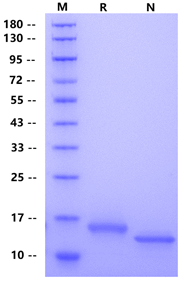Product Specification
| Species |
Human |
| Antigen |
IL-4 |
| Accession |
P05112 |
| Amino Acid Sequence |
His25-Ser153 |
| Expression System |
E.coli |
| Molecular Weight |
15-16kDa (Reducing) |
| Purity |
>95% by SDS-PAGE |
| Endotoxin |
<0.1EU/μg |
| Conjugation |
Unconjugated |
| Tag |
No Tag |
| Physical Appearance |
Lyophilized Powder |
| Storage Buffer |
20mM Tris, 150mM NaCl, 1mM EDTA, pH8.0 |
| Reconstitution |
Reconstitute at 0.1-1 mg/ml according to the size in ultrapure water after rapid centrifugation. |
| Stability & Storage |
· 12 months from date of receipt, lyophilized powder stored at -20 to -80℃.
· 3 months, -20 to -80℃ under sterile conditions after reconstitution.
· 1 week, 2 to 8℃ under sterile conditions after reconstitution.
· Please avoid repeated freeze-thaw cycles.
|
Background
Interleukin 4(IL4) was first identified as a helper T cell product with the capacity to co-stimulate B cell growth in vitro. IL-4 also can rescue B-cells from apoptosis, enhancing their survival, and is responsible for immunoglobulin isotype switching to IgG1 and IgE. The effect of IL-4 signaling is mediated through the IL-4 receptor alpha chain (IL-4Rα). Upon binding to its ligand, IL-4Rα dimerizes either with the common gamma chain (γc) to produce the type-1 signaling complex located mainly on hematopoietic cells, or with the IL-13 receptor alpha 1 (IL-13Rα1) to produce the type-2 complex, which is expressed also on non-hematopoietic cells. The type-1 signaling complex is critical for Th2-skewing of T cells and the development of alternatively activated macrophages (AAMΦs), while the type-2 complex plays a role in non-hematopoietic responses to IL-4 and IL-13.
























